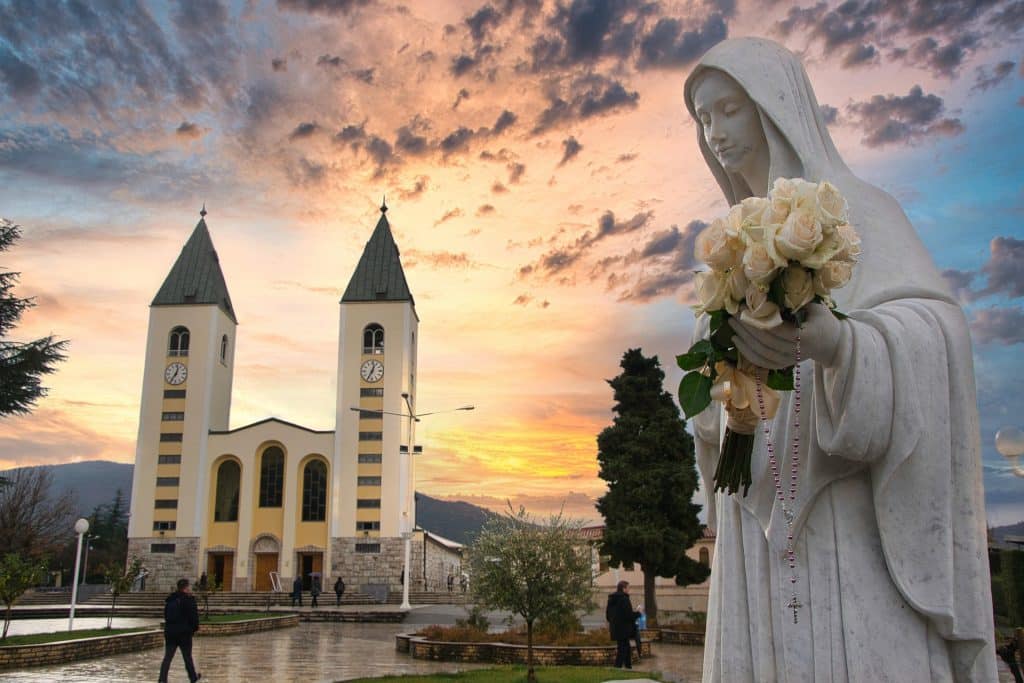This article originally appeared in The Skeptic, Volume 5, Issue 4, from 1991.
Although believers in the Medjugorje visions have dominated the media scene, skeptics have been doing their best to undermine the pro-vision propaganda. Frère Michel de la Sainte Trinité has been publishing periodic reports on the happenings, demonstrating the weakness of the claims; now he has brought his evidence together in a massive 510-page report which is essential reading for all students of the affair, and which throws fascinating light on the machinery which activates this kind of imposture.
The story is of course far more complex than the media versions would lead one to believe. On the face of it, it’s a simple, touching tale of a group of young village teenagers, from a quiet country district of Yugoslavia, who were privileged to encounter the Virgin Mary on a stony hillside on 24 June 1981, and to continue speaking with her on a virtually daily basis ever since. Apart from the personal messages for the visionaries, what the good lady has to say is pretty much what she said at Lourdes, Fatima, and on numerous other occasions: that we humans must repent of our naughtiness or it will be the worse for us.
The visionaries have been supported in their claims by some of the local clergy, though the local bishop is resolutely and outspokenly skeptical. Millions of pilgrims from all over the world have preferred to believe the visionaries themselves rather than their bishop; and the local authorities have come to look on the claims with more favour now that Medjugorje, once an obscure village, contributes 45% of Bosnia-Herzegovina’s tourist revenue. New hotels, cafes and shops, with streets, car parks and so on, are springing up to serve Medjugorje’s visitors: a definitive rebuttal of the visionaries’ claims would be a severe setback for the economy of the region…
Also involved is church politics: many of those favouring the visions adhere to a fashionable charismatic approach to religion, at odds in several respects with the established position of the Church. One of the priests most closely involved with the visions subsequently set up a religious commune, together with a Gennan girl who had been miraculously cured by the Medjugorje Virgin: the tenets of the commune were based on a declaration, by the Virgin herself, that love is the strongest weapon against Satan and that those who are ‘enflammées par l ‘amour’ will be the ‘front line’ confronting the devil. The rule of the community is that the Brother and Sister who head it shall ‘offer themselves in sacrifice of satisfaction one for the other’. My speculations as to what this actually means are no doubt a product of my prurient mind, but they certainly alarm, too, the author of the report… The fact that such goings-on have been explicitly authorised by the Virgin is alone sufficient grounds for questioning her authenticity.

Another of the priests, again one who was specifically nominated by the Virgin, is now known to have got a nun pregnant; in addition, the Virgin has shown herself unexpectedly partisan in respect of other controversial matters. All this could, I suppose, be taken as an indication that the Virgin is moving with the times, and becoming more permissive as she moves towards her third millennium; such, however, is not Frère Michel’s view, which is that the doctrines of the Church are unchanging, and that the visionary Virgin’s divergence from those doctrines is a strong reason for questioning her identity.
But in any case, all this is of course marginal to the central improbability of the affair: which is, that the Virgin would choose these particular inhabitants of this particular village, to visit daily – at a time and place of their choosing – on what now adds up to many thousands of occasions. Such improbabilities are of course glossed over in the pro-visionary propaganda, which has made Medjugorje an international best-seller. While his wife was receiving otherworldly counsel of a different kind, that great and wise statesman President Reagan was delighted to receive, in December 1987, a message from the Virgin, via one of the visionaries, and replied: ‘Now, I will go to my meeting with Gorbachev in a new spirit.’
His successor, also, is receiving heavenly aid on 15 November 1990, President Bush gave 20 minutes of his time when he might have been attending to other things, to meeting and talking with one of the visionaries who was touring the US.
Ironically, the best criticism of the Medjugorje nonsense has from the start come from within the Catholic Church. Père Ivo Sivric, a priest from Medjugorje now working in St Louis, Missouri, wrote an account of the imposture in The hidden side of Medjugorje (1988), a valuable report containing many important transcripts hitherto unpublished. Together with Frère Michel’s study, they present a factual review of the evidence, an exposure of the political and theological-political motivations involved, and the theological reasons for questioning the claims.
From the skeptic’s point of view, the ironies go yet deeper. For Frere Michel, writing as a devout Catholic, is by no means averse to the idea that the Virgin might return to our planet with helpful advice. He accepts the realities of the Rue du Bac, La Salette, Lourdes, Pontmain and Fatima visits (while rejecting many others, including Garabandal and San Damiano).
For him, there are only three alternative interpretations of Medjugorje:
- that the visions are what the visionaries claim them to be
- that they are deliberate imposture of psychological aberration
- that they are the handiwork of the Devil.
His book is a devastating demonstration that the first of these is untenable. Deliberate imposture he rules out, and, because the visionaries aren’t sick, and because he takes the traditional view that hallucinations etc happen only to sick people, he rules out psychological aberration also. So he is left with the only remaining alternative, that the whole thing is the work of Satan.
I imagine that most readers will share my feeling, that Frère Michel dismisses the psychological alternative too easily. It is evident that a person doesn’t have to be sick, in the conventional understanding of that word, to experience hallucinations and other mental phenomena. But is that what is happening to Vicka, Ivanka, Marija and the rest of the Medjugorje Six, Seven or Eight (depending on who’s counting)? So-called scientific tests were conducted by a French Dr Joyeux, with much parading of photos showing the visionaries in so-called ecstasy with electroencephalographic wires attached to their heads. But as Frère Michel demonstrates, the tests are wholly valueless and don’t even tell us much about the state of mind of the subjects, far less whether or not they are actually in the process of communicating with the Queen of Heaven.
What neither of these books do, beyond a limited point, is to go into the psychological issues involved. For this we must await the long-promised second volume of The hidden side of Medjugorje, currently being prepared by Louis Belanger, of the University of Montreal. But it is clear that a great number of psychological factors and sociological forces are at work in Medjugorje, giving us the opportunity to watch them at work beneath the spotlight of world interest. It is a saddening, even alarming, spectacle.
It is also a revealing one. One of the things the Virgin has said is that Medjugorje will be the last of her visits to earth. I hope she is wrong in this, as she has been wrong in so many of her predictions. Heaven knows who she is, or what she thinks she’s doing; but her visits always stir up a lot of interest, in believers and skeptics alike. We would miss her if she stopped coming.
References
- Frère Michel de la Sainte Trinite, Medjugorje en toute vérité, Editions de la Contra-Reforme Catholique, 10260 Saint-Parresles-Vaudes, France, 1991 .
- lvo Sivric, La face cachée de Medjugorje, (English translation The hidden side of Medjugorje), Psilog Inc, 465 Notre-Dame, SaintFrancis-du-Lac, Quebec, Canada JOG 1MO, 1988-89.





